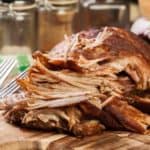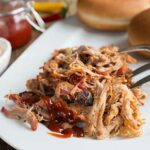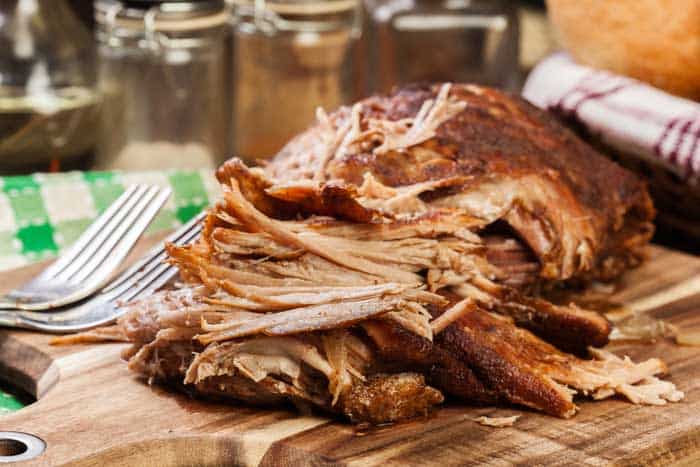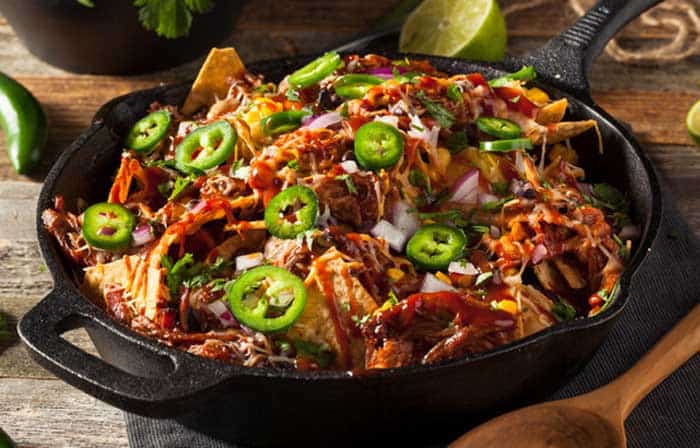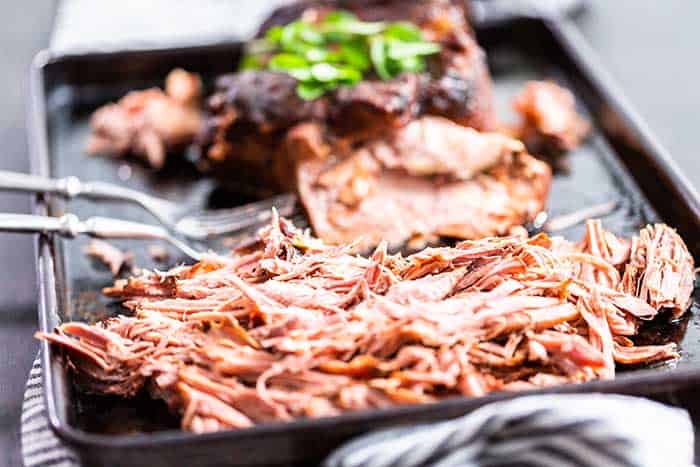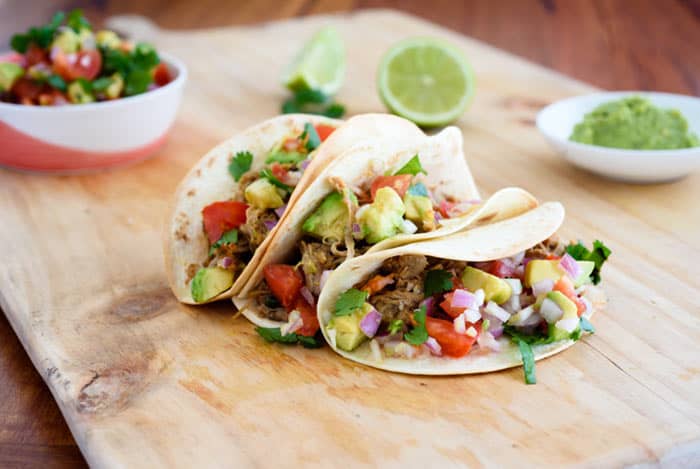Smoked pulled pork cooked low and slow over wood fire for the ultimate plate of barbecue meat. Learn how to trim, dry brine, and smoke this iconic cut of pork to perfection.
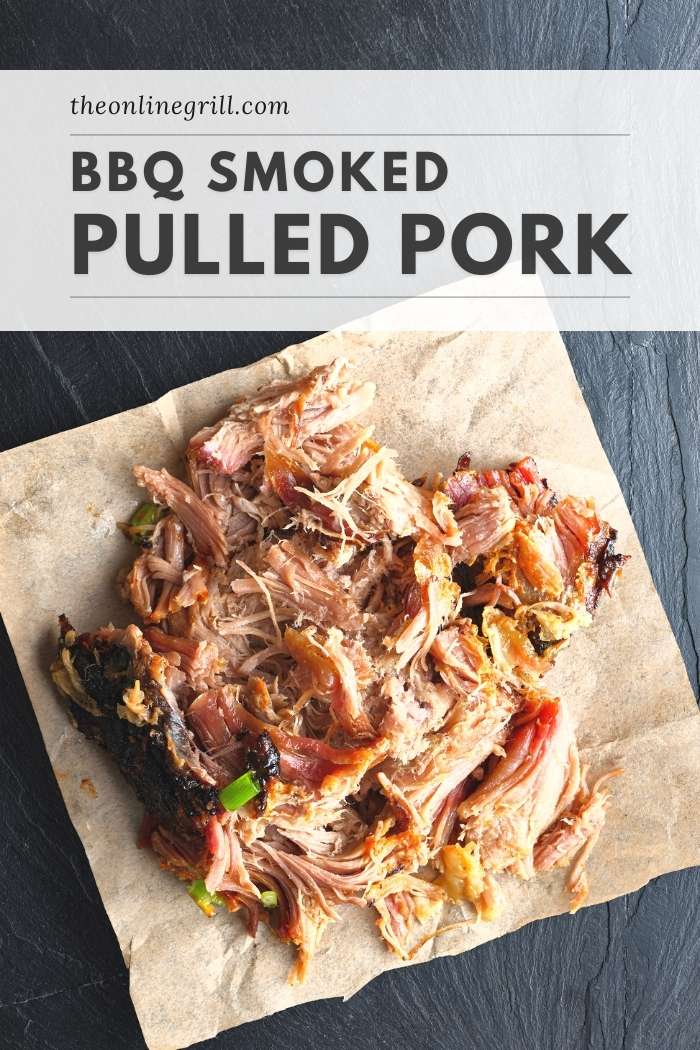
The pork shoulder has a great deal of fat and connective tissue running through it, making it prime for low and slow smoking. For perfect pulled pork, we smoke it for anywhere between 8 and 12 hours. It will take you all day, with some meat prep the day before, but the results speak for themselves.
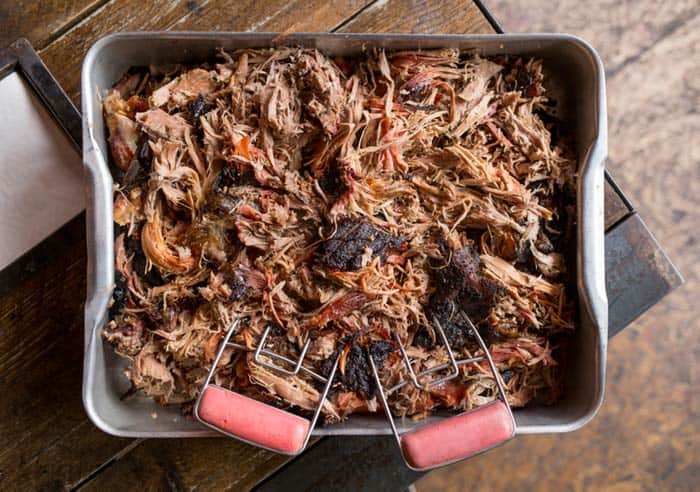
How Much Pork Will You Need?
Almost all meats experience a certain amount of shrinkage when they are cooked, especially pork. This can make calculating how much pulled pork to make a little complicated, but I have a fool-proof formula I follow.
This is the calculation I do when working out how much pulled pork per person I need. On average, one pound of BBQ pork will feed three people, so serve one-third pound of pulled pork per head. When pulled pork is cooked and shredded, it will lose half its weight. For example, a raw 8-pound pork shoulder will yield 4 pounds of shredded pulled pork, serving approximately 12 people.
Don’t be afraid of going over as pulled pork is one of the best meats for making leftovers. It can be easily stored and reheated in the following days.
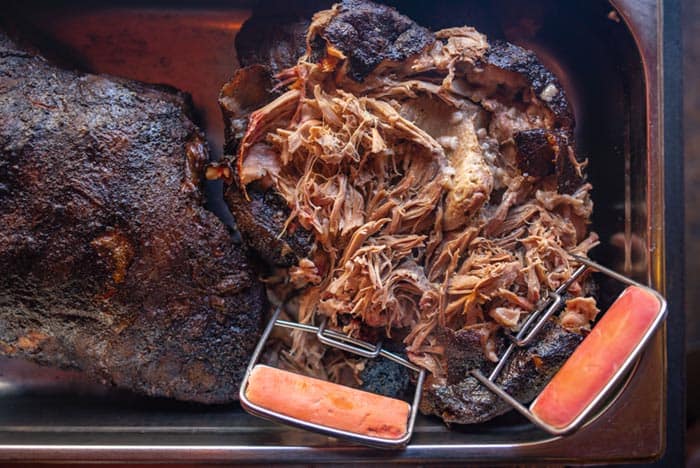
Pork Butt vs. Pork Shoulder
You might see some pulled pork recipes call for pork butt and some for shoulder. So what’s the difference and which should you go for?
Both pork butt and pork shoulder come from the shoulder of the pig, although they are slightly different in exactly where they come from within this cut. Pork butt (also called Boston Butt) comes from above the shoulder blades, while pork shoulder meat extends down to the pig’s front hoofs. Pork butt contains more fat and marbling, which makes it better suited to barbecue smoking.
Both cuts have plenty of tough and interconnected muscle, with connective tissue running between them. It’s for this reason that they need to be cooked low and slow for hours. This helps to break down and tenderize the tissue, giving us beautiful shredded pork at the end.
Trimming
The day before your smoke, get started on the meat prep. Place your pork shoulder on a chopping board and use a fillet knife to trim off the fat cap. This fat section doesn’t render when cooked, and we want to allow our dry brine, rub, and smoke to get into as much of the pork as possible.
Flip the shoulder over, and trim off any large pieces of fat or sinew. Find the seam in the butt, found on the other side to the fat cap. Divide and cut the butt into two pieces. This will help us marinate and season the butt more efficiently. Trim off any more excess fat or tissue on the two sections.
Don’t sweat over presentation, and it’s absolutely fine if there is some fat remaining on the meat. Finish by rinsing the meat under cold water, pat dry with paper towels, and let’s move onto the brine.
Dry Brine
While some people like to wet brine or marinate their pork shoulder, I prefer to dry brine it overnight. This saves effort and ingredients while also doing the best job of ensuring tender and juicy meat without overpowering its natural flavors.
Apply kosher salt across all surfaces of the meat, and massage it in well. Leave the pork in the refrigerator overnight for the best results.
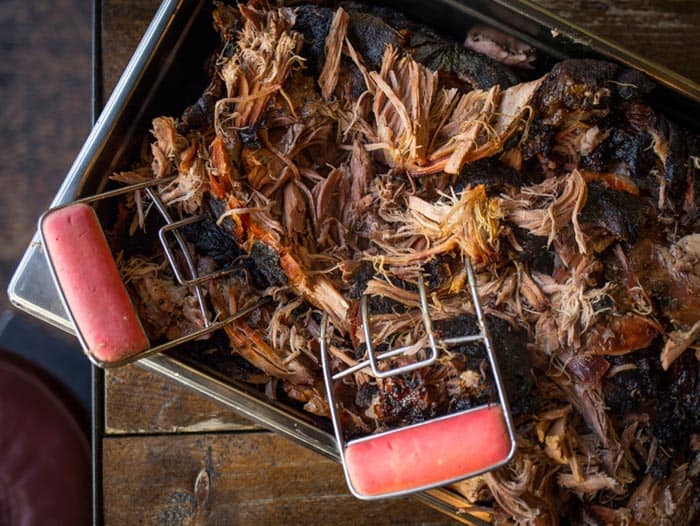
Times & Temperatures
Pork butt or shoulder needs to be cooked for about 90 minutes per pound of meat at 225°F, or until internal temperature reaches 203°F (95°C). We are using a 5lb pork shoulder, so we can expect about an 8-hour cooking time.
Variables like meat thickness, smoker heat retention, and fat content can all affect smoking time. I urge you to use a meat thermometer to gauge your meat’s doneness instead of going by time.
Technically, pork is safe to eat once it hits 145°F, but we need pork shoulder to be well done to reach a level where we can ‘pull’ it. At 203°F it’s at its most tender and the perfect texture we look for in pulled pork.
Smoking Wood
Apple or pecan wood chips are the best woods for smoking pulled pork. Both have a slightly sweet and fruity taste, as you would imagine. It’s also highly adaptable because no matter what cut of pork you choose with your pulled pork, it’ll go well with it. If you’re going to blend BBQ sauce with your finished food, I think apple is a decent idea.
However, since applewood is so subtle, it can take a long time to make its way into pork. If you plan on cooking the meat for several hours at a low temperature, this is perfect, so if you want to shorten the cooking time, something else should be considered.
How to Smoke Pulled Pork
Fire up your smoker to 225°F (107°C), or set up your grill for two-zone cooking or indirect grilling. Once it’s at the target temperature, put apple or pecan chips in the wood tray or on the coals.
Transfer pork butt to smoker grates. Close the chamber door and smoke for five or six hours, spritzing every hour until the meat’s internal temperature has reached 165°F (74°C).
As the temperature approaches 150°F, you might see the pork hit the BBQ stall. This is where the surface moisture of the meat evaporates, simultaneously cooling the pork. This phenomenon makes it difficult to push past and continue to raise the temperature to 170°F, where the connective tissue in the meat starts to melt, and the surface starts to turn to bark via the Maillard Reaction.
My way around this is to wrap the pork in foil. This is a method known as the Texas Crutch, and is normally seen with brisket. The method works by preventing moisture from escaping and cooling. The other advantage of this is that it will significantly cut down our total cook time, potentially saving up to 4 hours.
Any cons? Well, the thick layer of moisture this creates around the pork means your chances of developing a bark will be limited. It’s your choice, but since we’ll be pulling the pork my personal preference is to wrap it.
Once the internal temperature has hit 203°F, remove it from the smoker. The outside of the pork should be a beautiful dark brown color and you should be able to see evidence of rendered fat on its surface. With any joy, you’ll be able to see a smoke ring immediately beneath the surface of the meat. It’s not the be-all and end-all, but major kudos if you manage it.
Transfer the pork shoulder to a large pan. Use bear claw shredders to tear into the pork.
Use claws to shred the pulled pork. If you find any large chunks of fat, throw them away. If you find any bark, be generous and spread it around evenly for your guests. If you have any leftover juice from the cook, repurpose it by pouring it back over the meat.
Sides & Serving Ideas
Need something to go with your smoked pork? Any good BBQ platter needs its fair share of pulled pork sides to complete the meal. Here are some of our favorites:
- Southern-Style Smoked Beans
- Red Cabbage Slaw
- Potato Bread Rolls
- Sweet Corn Fritters
Pulled Pork Leftovers
Leftovers are often inevitable, but in the case of pulled pork, I always try to make a little extra. It’s easy to reheat during the week, and enjoy either on its own or incorporated into another recipe.
You can quickly reheat pulled pork by mixing it with some barbecue sauce and reheating it in a saucepan over medium-low heat.
While sandwiches are the obvious option, there are so many more creative ways to use leftover pulled pork than you might think. Here are a few of our favorites:
Pulled Pork Tacos
Tacos don’t require much of an introduction. They’re tasty, versatile, and can be customized to suit any dietary requirement. Our smoked pulled pork tacos combine juicy and tender pork meat with citrus, minced red onion, and BBQ sauce for a mouthful of punchy flavor.
Nachos
Is there anything better than nachos for a party? By grilling them, these smoked pulled pork nachos take something wonderful about the crowd-pleasing classic to a whole new dimension. The nachos are covered with a thin layer of applewood chips and grilled over charcoal and wood to give them a special taste that still honors the true star of the show: the pulled pork.
Jalapeño Poppers
If there’s one surefire to improve jalapeño poppers, it’s with pulled pork shoulder. I like to add a touch of sriracha and bacon.
Pizza Topping
Pork. Cheese. Pizza. Say no more. Try throwing your leftovers onto a simple margherita pizza, add a touch of BBQ sauce and extra cheese melted on top.
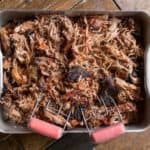
Smoked Pulled Pork
Equipment
- Apple or pecan wood
- Food-safe spritz/spray bottle
Ingredients
- 5 lb pork butt
- 2 ½ tsp kosher salt
- 2 tbsp yellow mustard
- ½ cup BBQ dry rub
- 1 cup BBQ sauce
Spritz
- 1 cup apple cider vinegar
- 1 cup water
Instructions
- Trim the fat cap off the top of the pork butt, and any excess fat on the other side.
- Find the seam in the butt, found on the other side to the fat cap. Divide and cut the butt into two pieces. This will help us marinate and season the butt more efficiently. Trim off any more excess fat or tissue on the two sections.
- Cover the two pieces in kosher salt, evenly covering all sides. Leave in your refrigerator overnight to dry brine.
- The next day, remove pork from refrigerator. Rinse off residual salt with cold water and pat dry. Apply a thin layer of mustard all over pork. Rub BBQ dry rub into pork.
- Fire up smoker to 225°F (107°C). If you are using a grill, ensure you set up for 2-zone cooking.
- Add apple or pecan chips to smoker or coals. Place pork butt on smoker grates. Smoke for 5-6 hours, or until internal temperature is 165°F (74°C). Spritz every hour.
- Wrap pork in foil. Increase temperature to 325°F (163°C) and smoke for 2-3 hours, or until internal temperature is around 203°F (95°C).
- Remove pork from the heat and place it in a pan to begin pulling. If you don't have a shredder you can use a pair of forks. Take out any large chunks of fat. Spread crusty bark evenly and work in BBQ sauce.
- Serve about ⅓ lb per head, either as sandwich or taco filling, or on its own.

